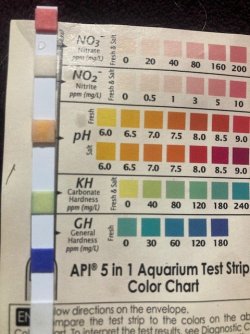VioletThePurple
Fish Crazy
My platy and probably cory that I just bought yesterday I woke up to find dead. The reason I say the cory is probably dead and not certainly is that I can't find it, or any remains of it in the tank. I'm assuming my snails ate it since they were already picking at the platy when I had removed it. I had bought two cories, as there were only the two in the store tank. I feel bad for my little buddy now because he lost his friend. But obviously I shouldn't go buy more fish right away until I take care of the problem in my tank. I tested my nitrates, and it was red, meaning at least 40 ppm assuming I did the test right. I know this is relatively high, so I did a water change. Should I do daily water changes until the nitrates are at a low level? I can test my other water parameters if needed, but I accidentally ended up mixing the nitrite solution with the nitrate solution as I'm in a bit of a frenzied state right now.


